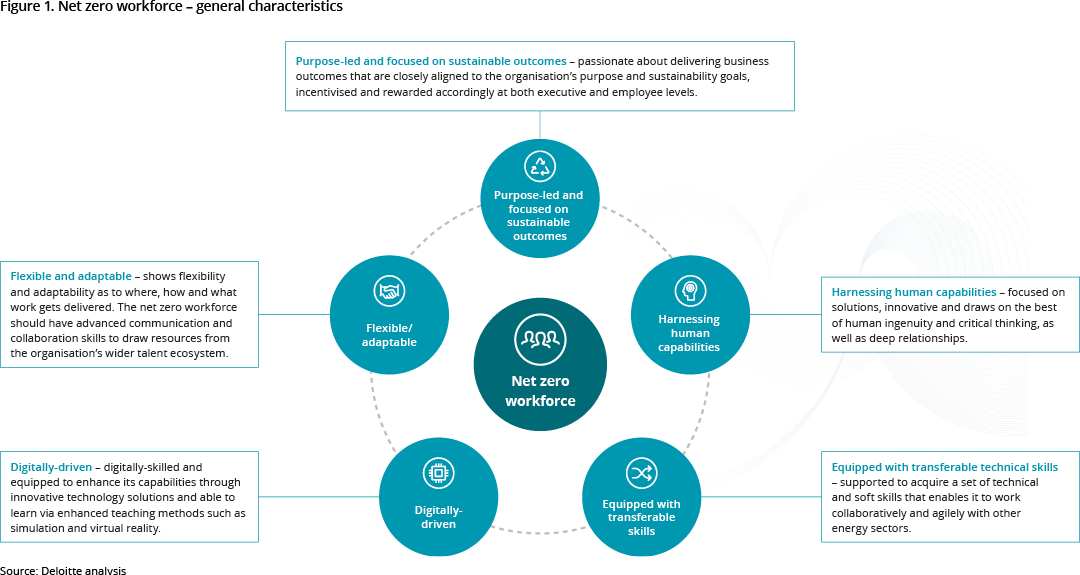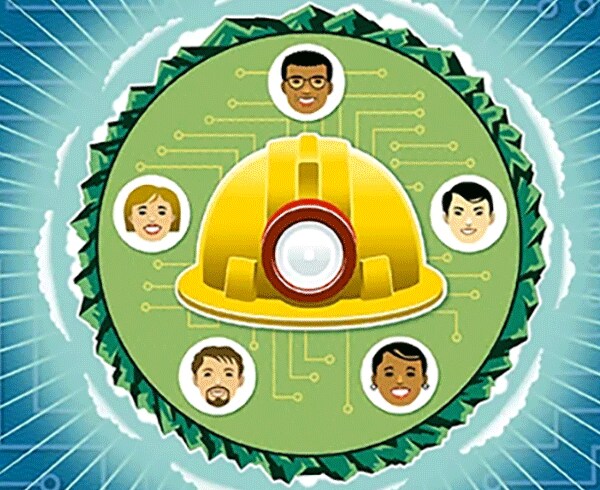The net zero workforce: Mining & Metals
At the intersection of decarbonization and digitalAs the digital transformation accelerates, mining and metals companies will not only need investment and innovation, but also new skills and capabilities, and a well-supported and motivated workforce to tackle decarbonization challenges.
With clean energy technologies being more mineral intensive than fossil fuel-based generation, they need to meet the growing demands of globalization, while also trying to appease investor and governmental pressure on environmental, social and corporate governance (ESG) concerns.
Most diversified miners have already set environmental impact reduction targets in response to ESG pressures. However, pressure on miners to decarbonize more aggressively may increase as more global action will be needed to meet the Paris Accord’s aim of limiting the global temperature increase to below 2 degrees Celsius, preferably to 1.5 °C. Therefore, working with a wider set of stakeholders to reduce consumption by incorporating circular economy concepts and increased recyclability in the mining lifecycle will be essential to position an organization for a sustainable future.
This article looks at the intersection between the Future of Energy and the Future of Work. It explores how mining companies can improve their workforce approach to maximize opportunities in energy transition.
The Future of Energy: Challenges and opportunities
Several top mining jurisdictions are drawing up decarbonization plans in response to the Paris Accord that holds countries accountable for climate change.
Canada has committed to achieve net zero emissions by 2050. Its Net-Zero Emissions Accountability Act is expected to enshrine the country’s target in law and establish a process to set five-year emission reduction targets from 2030 as well as to develop a credible plan to meet each milestone.
Australia has not committed to net zero yet, but is signalling a change soon as it aims to reach zero emissions “as quickly as possible and preferably by 2050”. In line with the Paris Accord, the country’s current target is to reduce greenhouse gas (GHG) emissions to 26-28 percent below 2005 levels by 2030.
South Africa aims to reach net zero by 2050, according to the Low Emission Development Strategy (LEDS), developed in response to the Paris Accord. LEDS is based on three policy documents: the National Development Plan, with the objective to eliminate poverty and reduce inequality by 2030; the National Climate Change Response Policy, the government’s policy framework for climate change; and the Climate Change Bill, which will form the legislative foundation for the country’s climate change response.
China aims to hit peak emissions before 2030 and reach carbon neutrality by 2060, according to President Xi Jinping.
Pressure is mounting on mining companies to support national decarbonization targets in their host countries. The potential for carbon taxes in a number of jurisdictions also provides incentives for mining companies to engage more effectively in energy transition. In light of these sustainability challenges, many companies are conducting systemic reviews of their asset portfolios and several have already published decarbonization plans. These plans reveal that most mining companies see energy transition challenges and opportunities materialize in two primary areas:
- Reducing environmental impact, with a focus on cutting GHG emissions. Many mining companies are starting to move beyond identifying risks associated with carbon emissions and beginning to implement their decarbonization plans. In terms of execution, most miners are primarily focusing on direct and indirect (purchased electricity, heat and steam) emissions and concentrating on:
- operational efficiency improvements to reduce energy and water consumption; and
- electrifying operations, material movement and processing, and using renewable energy sources, where possible, to minimize the use of fossil fuels.
- Providing green and critical commodities for energy transition. Efforts worldwide to replace fossil fuels in electricity generation, transportation and heat with cleaner, preferably renewable, fuel sources, are fundamentally changing the demand profiles of a number of commodities. While steel raw materials (iron ore and metallurgic coal) will continue to dominate the project portfolios of many diversified miners over the next decade, the proportion of energy transition commodities is rising. As a result, demand for the following commodities is expected to increase:
- Copper – driven by growing electricity consumption;
- Lithium, nickel, cobalt, graphite, manganese, vanadium and zinc – driven by increasing demand for batteries in electric vehicles and energy storage applications; and
- Platinum, palladium and other catalyst materials – driven by the projected growth in hydrogen fuel cells and carbon capture and storage capacity globally.
Transition commodities offer some great new business opportunities for miners. For example, the World Bank estimates that to keep temperatures rising less than 2C, graphite, lithium and cobalt production would need to ramp up by more than 450 percent by 2050 to meet demand for energy storage technologies. However, demand for such commodities remains highly uncertain and supply shortages could quickly develop. Addressing the potential demand/supply imbalances, as well as ensuring the ethical sourcing of some of the green and critical commodities and rare earths, will be a key challenge for the sector.
The Future of Work: Challenges and opportunities
Discussions about the future of work are moving beyond the impact of digital transformation and the effectiveness of remote working strategies. Therefore, it’s time to explore how the future of energy and technology are changing work and the location where work is delivered, and what skills will be needed in the mine of the future.
- Future of energy is changing work: Energy transformation is more than shifting from fossil fuels to clean energy sources. It’s about redefining energy systems. The impact on miners could include:
- Shifting the focus from supply chain to asset ownership. Energy transition reduces the need for mining companies to rely on energy supply chains to ensure fuel is delivered, storage is full, and/or electricity contracts are in place. Instead, miners will typically own and operate the renewable energy assets such as solar PV, wind, electrolyzers, energy storage, etc. Even if the energy assets are owned and operated by a partner or the community, mining companies will need visibility of the operations and status of the energy supply assets and renewable resources. This will require miners to have a dedicated workforce in place to operate or work with the asset owners to ensure uninterrupted energy supplies.
- Integrating energy management and workflow planning into the digital nerve center. Miners should establish digital nerve centers and aim to manage energy flows and workflows in more integrated, dynamic ways. This would help improve the resilience of their power grids and minimize the amount of physical storage needed. However, this level of optimization will require that the nerve center has full visibility of the energy ecosystem (visibility of the current status of the electricity supply and storage capacity as well as electricity provision in the hours and days ahead) and that the energy system works predictably. Nerve centers will need artificial intelligence and a skilled workforce to manage and constantly improve the system’s performance. An example of energy management and workflow coordination/integration could be storing work instead of energy: hydrogen fuel trucks could be used to haul material into stockpiles at night and then process this material during the day when solar energy is available, instead of over a 24-hour period that would require large energy storage investments.
- Using digital for higher environmental impact. For example, digital twins allow mining companies to conduct exploration, troubleshooting, and planning without having an impact on the environment as a digital twin can be accessed, analyzed, and operated remotely/virtually. Digital twins of drill and blast designs and digital modelling life-of-mine plans can make forecasting, allocation, monitoring, and managing of resources and assets more accurate and efficient. However, creating digital twins and virtual models and work plans require new and unique skill sets including critical thinking, data visualization, and pro-active decision-making based on predictive analytics.
- Shifting the focus from supply chain to asset ownership. Energy transition reduces the need for mining companies to rely on energy supply chains to ensure fuel is delivered, storage is full, and/or electricity contracts are in place. Instead, miners will typically own and operate the renewable energy assets such as solar PV, wind, electrolyzers, energy storage, etc. Even if the energy assets are owned and operated by a partner or the community, mining companies will need visibility of the operations and status of the energy supply assets and renewable resources. This will require miners to have a dedicated workforce in place to operate or work with the asset owners to ensure uninterrupted energy supplies.
- Technology is changing work: Robotics and automation are becoming more widely adopted across mining enterprises through sensors, drones, remote controlled systems and cloud computing. While these innovative technologies help enhance efforts in exploration, and make mining operations, processing, transportation and trade more efficient and safer, they also have a profound impact on all mining occupations and the skills needed to perform them. Change management skills, advanced system development and integration skills, data science and digital literacy skills, higher level operations and planning skills, business information systems operations and analysis skills are among the new core skills that mining companies are looking for. The ability to work alongside and effectively incorporate artificial intelligence, machine learning, augmented reality tools and robotics into day-to-day activities is also expected to become critical for mining companies.
- Location of work is changing: Mining companies have adopted quickly to the new normal during the COVID-19 pandemic, but now they have an opportunity to sustainably embed some of the changes they implemented in business operations. Some practical examples of sustainable change to business operations, which coincidentally also contribute to lower carbon emissions, include:
- Utilizing mixed reality technologies to remotely tap into specialist expertise and advisory services (e.g. specialist engineering advisory services and/or troubleshooting);
- Embracing and adopting virtual conferencing technologies to conduct both strategic and operational meetings as opposed to traveling to a single onsite location;
- Optimizing shift rotations by using short interval control and near real-time updates to manage resources and workplans better; and
- Reducing travel times to site meetings and daily operational updates through virtual updates.
However, the right balance needs to be found between face-to-face and remote delivery to enhance the workforce experience, as well as equip employees and managers alike with the relevant skills for effective virtual work, asynchronous collaboration and effective virtual management.
- Utilizing mixed reality technologies to remotely tap into specialist expertise and advisory services (e.g. specialist engineering advisory services and/or troubleshooting);
What should mining and metals companies do?
Creating and taking advantage of opportunities in energy transition and managing a mining company’s environmental and social impact are undeniably complex tasks. Technology and innovation will play a crucial part in achieving these aims. Miners therefore must ensure they have access to an ever-evolving set of technical as well as soft skills and capabilities to participate effectively in energy transition.
-
Include sustainability in your business purpose and underpin it with strong leadership
Targets and pathways to minimize a mining company’s carbon footprint are likely to be set out by central sustainability offices but executing them and spotting new opportunities to amplify their impact will require the entire company’s workforce. Everyone across the business must play their part and bring fresh ideas to how the company can meet and exceed its environmental obligations sustainably.
It is therefore key that mining companies have a clear, sustainability-driven purpose that each employee understands, relates to and feels passionate about. A well-defined purpose also creates a much-needed bond between the workforce and the organization. This bond results in the necessary trust, which is essential for the effective digitalized and remote delivery of tasks.
There is also a need for strong, visible and human leadership that identifies with the purpose, articulates it well, and creates the environment to put vision into action – it empowers people to think differently, lets them experiment, and gets them to collaborate across boundaries. - Focus on skills for energy transition – not only industry experience
Carbon footprint management includes quantifying and analyzing a company’s emissions data, setting targets, articulating abatement pathways, forecasting costs, values and timings, as well as closely liaising with stakeholders around targets, actions and progress. While these specific technical skills are not typically associated with the sector, top miners are already building teams that include such expertise with pressure from governments and stakeholders increasing.
While engineering skills will continue to play a central role, in the future they will need to incorporate a more robust understanding of how they can be used to minimize environmental impact and further expand their technical skill set aligned to ESG priorities. With mining operations becoming more digitalized and electrified for a lower carbon footprint, more miners are likely to need more electrical and software engineering skills, as well as digital, data and cyber capabilities and behaviors associated with systemic and holistic thinking. Mining companies will also likely to need expertise to replace fossil fuels with cleaner sources of fuel, such as hydrogen, and explore opportunities in carbon capture and storage.
In addition to the changing requirements from a technical point of view, mining companies also face multiple other uncertainties. These include the future demand for many transition commodities, the potentially rapid change in political and social settings where these commodities will be mined, and the impact of digitalization on the organization and the workforce. To navigate these challenges successfully, flexibility, adaptability and resilience will be key soft skills and capabilities that mining organizations need, along with a mindset focused on innovation and problem solving.
The ability to collaborate with customers and suppliers to explore how circular economy principles can be embedded into the mining lifecycle and working with other sectors such as the oil, gas and chemicals or renewables sector to reduce the carbon footprint of mining will be crucial. Mining companies should also continue expanding their soft skills and capabilities to collaborate with host governments and local communities on issues including upskilling and reskilling for digital transition, transformation and sustainability.
Miners, therefore, should focus on acquiring the skills and human capabilities they need for engaging more effectively in energy transition.
In summary, companies should build the net zero workforce, whose principal characteristics are summarised in Figure 1.

Build the net zero workforce
Building the net zero workforce should start by redefining work in three different, yet intrinsically connected dimensions: the work itself, the workforce and the workplace. The area below highlights potential areas companies should consider.
- Are you restructuring work to make your workforce’s activities more efficient? What can you stop and what can you automate?
- In addition to automation, how are you using technology to enhance your workforce’s skills and capabilities?
- How can you turn work from task completion to problem solving and managing relationships?
- Which roles can be performed sustainably on a remote or hybrid basis?
- How do you motivate and reward workforce to align with your decarbonization goals?
- Do your hiring strategies help you compete for non-energy industry specific skills?
- How can you build internal talent marketplaces that identify technical skills, capabilities and interests as well as proficiency levels?
- How can you curate personalized experiences to maximize your workforce’s potential?
- How can you shift the focus from a physical workplace without losing the organization’s sense of culture and belonging?
- How can you redesign the workplace so that it becomes a place of collaboration, innovation and personal connection?
- How can you create a diverse and inclusive culture that empowers and enables the workforce?
- To what extent will you embrace remote working that could allow you to recruit from a wider talent pool?
When focusing on the workforce, organizations first need to understand what the desired work outcomes are. Next, they will need to follow a set of steps to anticipate both the technical skills and soft skills the workforce will need in the future. Once these are identified, companies will need to assess where potential gaps could arise and develop a strategy and roadmap to meet future workforce requirements. Key considerations are shown below.
- what skills and capabilities your organization will need in the future and at what proficiency levels
- whether leadership has the skills to manage new technology and energy transition
- what proportion of skills should be core and what can/should you borrow from other sectors
- what skills can you enhance by technology and what can you automate
- your workforce, project partners, suppliers, contractors, managed services, crowd sourcing platforms and collaborative partners, including skills academies and universities
- passions and special interests
- requests for work scheduling patterns and other personal requirements or circumstances
- which skills you will acquire and which ones will you develop
- how you will access your broader talent system to complement your existing skill set
- to what extent you will enable remote working with appropriate policy and compliance infrastructure
- creating a leadership development and succession plan aligned to energy transition objectives
- how you will use technology to enhance your workforce’s capabilities
- dynamic learning and development programs to support learning in the flow of work; leadership development program and succession management; refreshed workforce mobility and talent acquisition approaches; a reward system aligned with energy transition/net zero objectives and based on value to the business; workforce composition and contingent workforce management; technology initiatives.
In addition, organizations should consider the following questions:
- What additional support mechanisms are needed to keep the existing workforce focused on delivering the strategy?
- How can staff be encouraged to explore new technologies and work with new talent toward sustainable goals?
- How to create incentive mechanisms specific to certain Millennials and Gen Z who may view long-term incentives less attractive and change employment more frequently?
- How to develop a workforce that not only has the core technical and soft skills and capabilities for the near term, but can also access less specialized skills to scale up quickly if necessary?
In summary
Now is the time for mining and metals companies to realign their purpose and strategy to focus on decarbonization and ESG goals. Energy transition provides companies with an excellent opportunity to re-energise their workforce approach and create an environment for attracting and fostering the right talent with the right skills and capabilities to achieve their sustainability goals.
Delaying or indeed failing to prepare the workforce for energy transition can lead to missed opportunities. Companies might not have access to the right skills at the right time to meet their decarbonization targets or be able to take advantage of opportunities in energy transition. The cost of decarbonization for companies could rise, or targets could be missed. Individuals may lose out on work and/or development opportunities. Therefore, mining companies should include sustainability in their purpose, and focus on the technical and soft skills, rather than only on the industry experience and knowledge, needed for energy transition. Following the future of work framework for net zero should lead to a highly skilled workforce ready to deliver cleaner and more sustainable outcomes for the benefit of both the organization and wider society.
Get in touch with the team

Andrew Swart
Global Sector Leader—Mining & Metals

Janine Nel
Partner, Consulting

Marc O'Connor
Partner

Sonia Storr
Partner

Netti Farkas Mills
Energy, Resources and Industrials Senior Insight Manager
Related content

The future of energy
Energy is the pulse of our day-to-day life and how we create and use it is changing rapidly. What the future will look like is not certain, but what is clear is that we’re well on our way to a new energy future. Imagine the possibilities… A world where energy is sustainable and abundant.
Tracking the trends 2021
The top 10 issues transforming the future of mining.

The future of work in mining
What will jobs look like in intelligent mining operations?